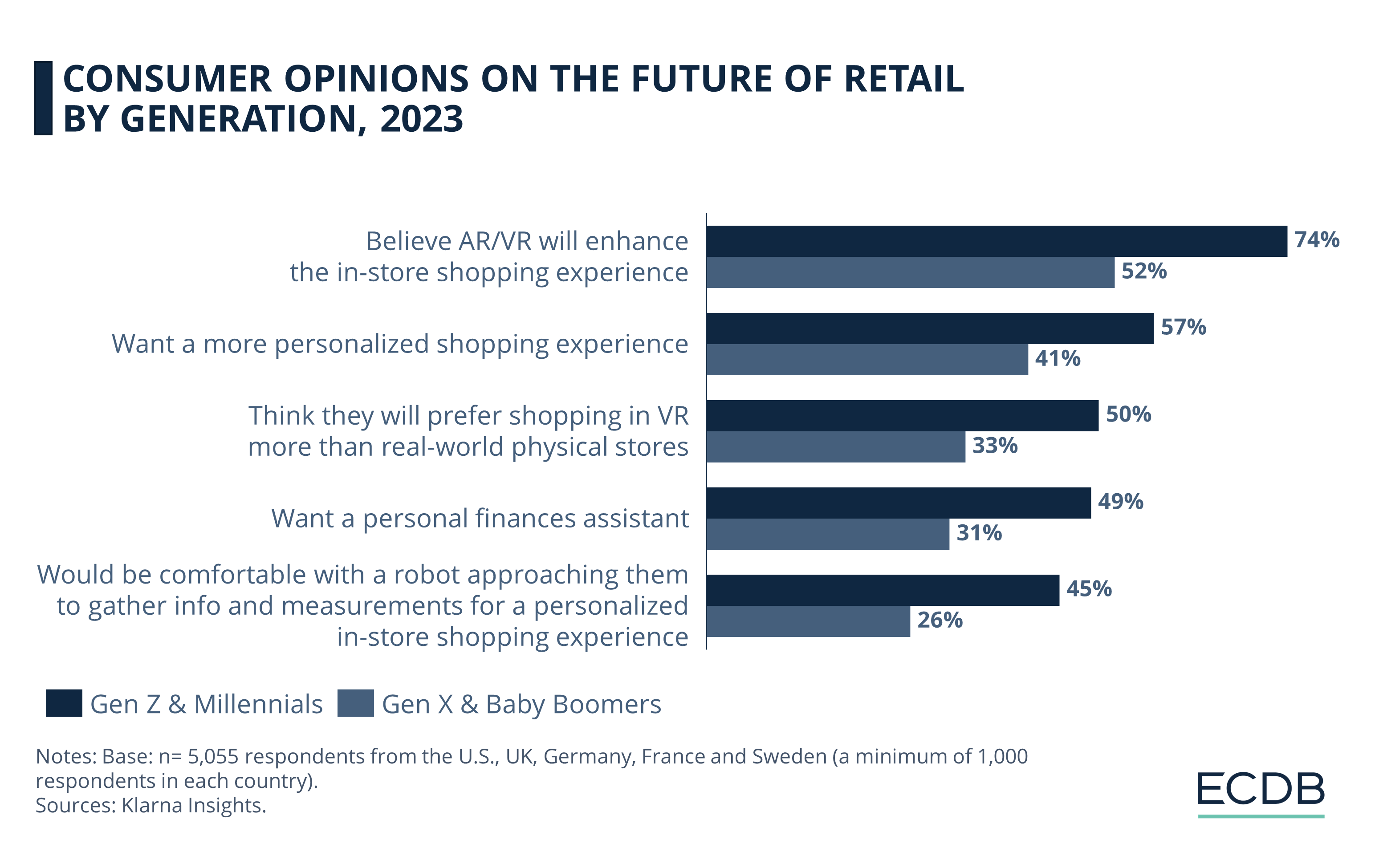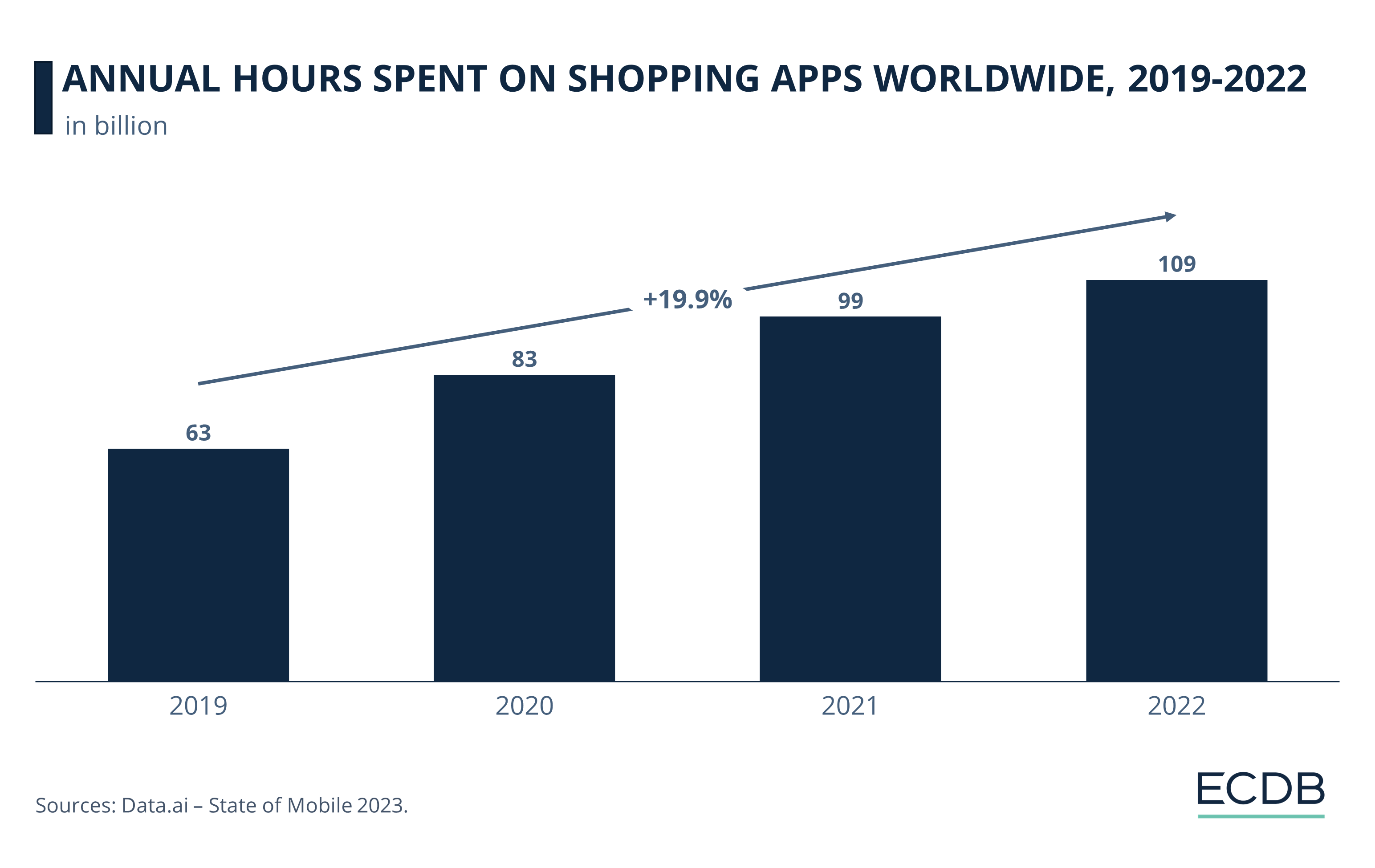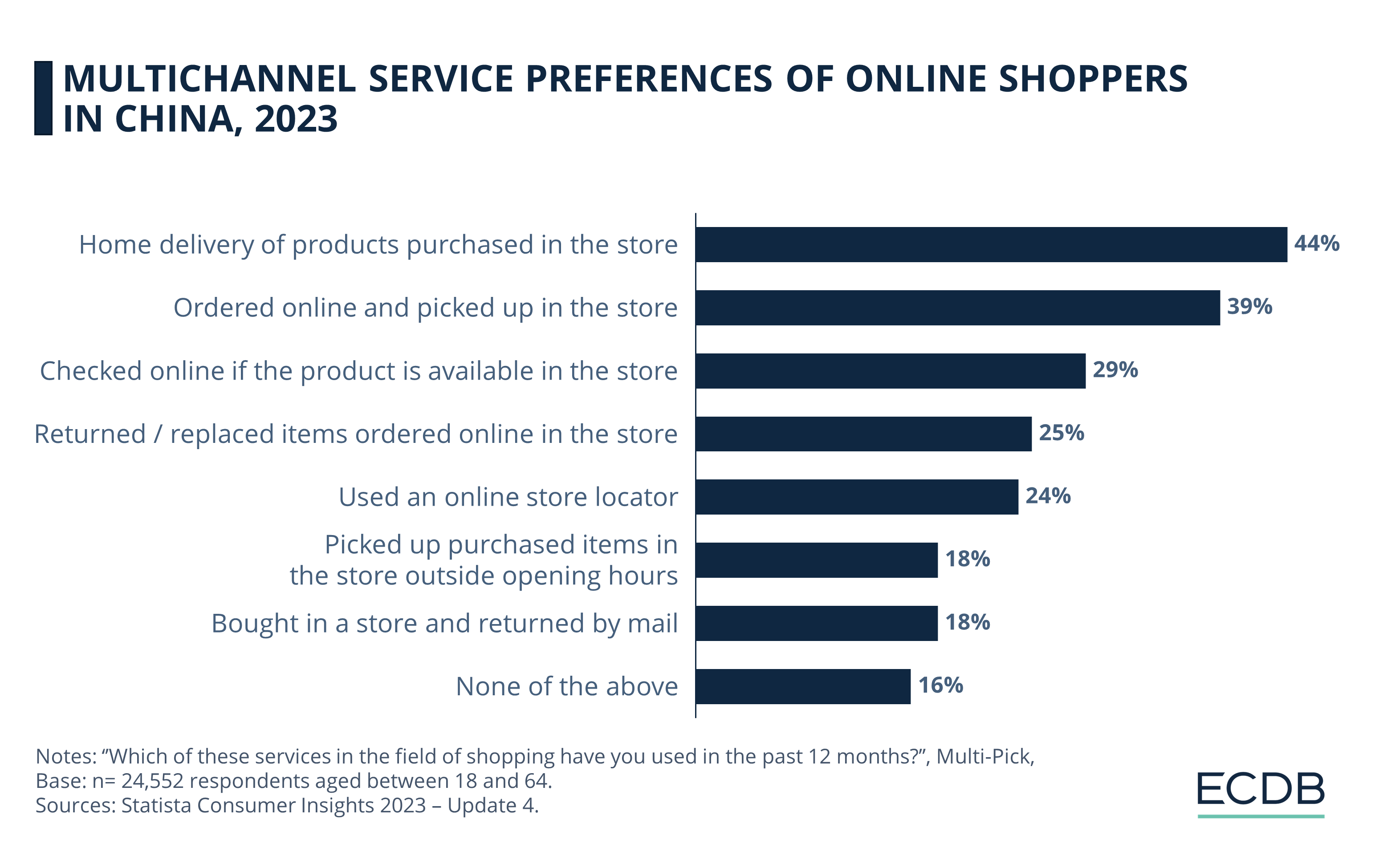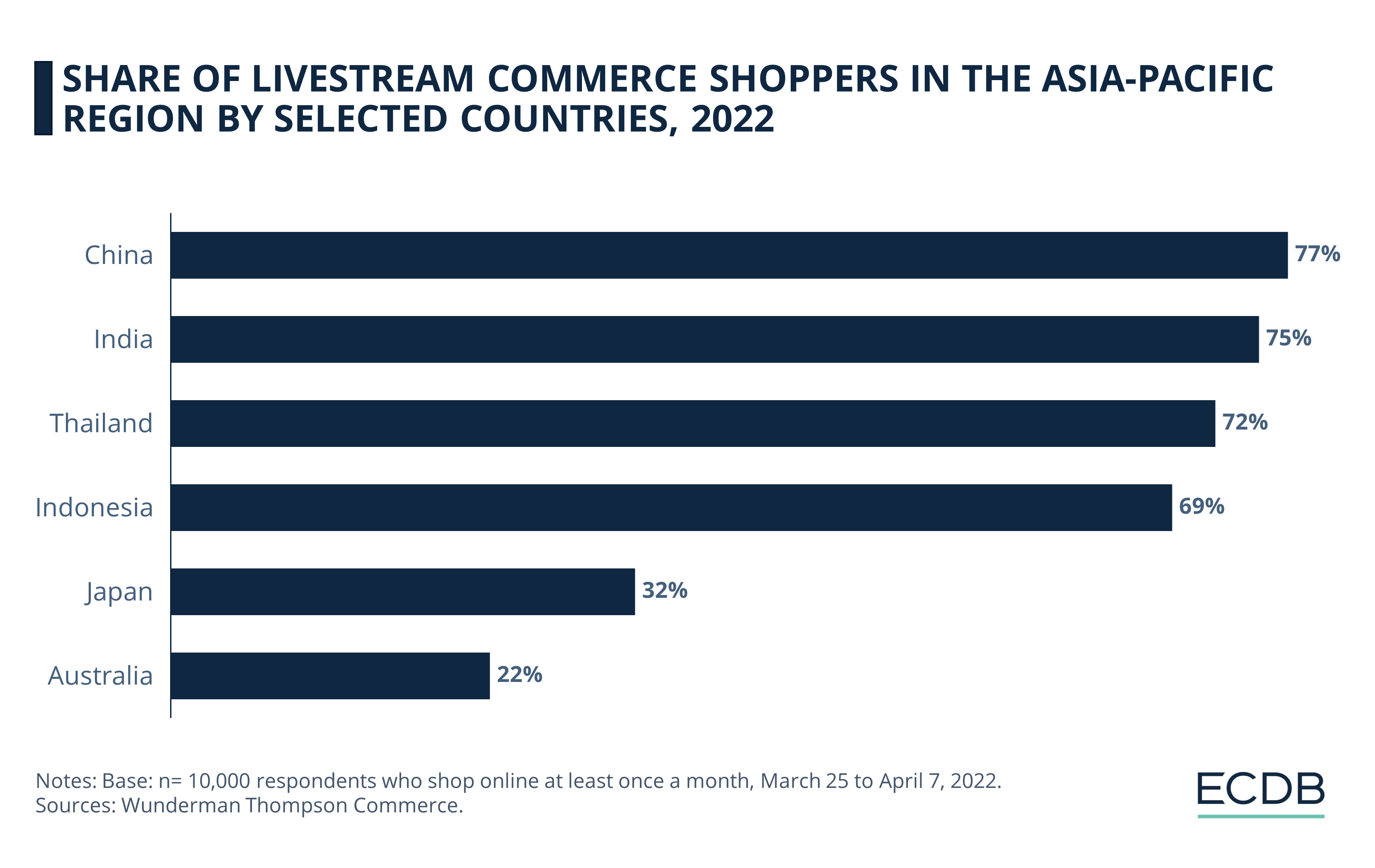AI & AR Trends in eCommerce
Artificial Intelligence & Augmented Reality Creating the Shopping Experience of Tomorrow
Step into the future of shopping with our guide on the 10 eCommerce trends of 2024. Discover how AR, VR, and AI are transforming the way we shop, from virtual try-ons to voice-activated orders.
Article by Cihan Uzunoglu | February 09, 2024Imagine a world where trying on a pair of glasses doesn't require stepping into a store, or where your voice can summon any product to your doorstep. This isn't a scene from a sci-fi movie; it's the reality of shopping in 2024, where augmented reality (AR) and virtual reality (VR) merge digital with real, and voice and image searches transform how we discover products.
From the comfort of your mobile device, the future of commerce unfolds through personalized marketing powered by artificial intelligence (AI), sustainable practices that align with your values, and seamless multichannel support that understands and anticipates your preferences.
To capture this ever-changing landscape, we put together the 10 eCommerce trends you should watch out for in 2024, showcasing how technology and consumer preferences are driving a more immersive, efficient, and personalized shopping experience.
Augmented Reality (AR) & Virtual Reality (VR)
The adoption of AR and VR technologies in eCommerce is increasingly reshaping consumer shopping habits globally. With innovations like smart glasses, users gain interactive experiences that merge digital with real, providing real-time information and enhancing engagement.

Half of European consumers are enthusiastic about these technologies, as we reported in the cases of Poland and Greece. Extended reality (umbrella term for AR and VR, as well as mixed reality) not only makes online shopping more interactive and enjoyable, but also addresses practical concerns like reducing returns. By allowing virtual try-ons, these technologies enable customers to make more informed decisions, reducing dissatisfaction.
The flexibility offered by headless commerce architectures further empowers retailers to integrate AR and VR seamlessly, enhancing customer experiences and opening new avenues for engagement. One good example of this is Metaverse Fashion Week. The event highlighted the potential of AR and VR to revolutionize the retail landscape, offering immersive digital fashion experiences and setting new benchmarks for customer interaction in eCommerce.
Voice and Image Search
As exemplified in last year’s Amazon Prime Day, the integration of voice search through smart devices like Alexa is changing how consumers find and reserve products, underscoring the shift towards more interactive shopping experiences.
Parallelly, visual search, which allows users to search for products with images instead of words, simplifies finding specific items by analyzing photos and providing instant information on availability and pricing. Retail giants such as Amazon, eBay, and Alibaba have adopted visual search, enabling shoppers to discover products effortlessly through mobile applications or web platforms.
These innovations in voice and image search are pivotal in eCommerce, offering a more intuitive and personalized shopping journey, enhancing product discovery while simultaneously encouraging exploration and engagement, setting a new standard for customer interaction.
Artificial Intelligence (AI) & Machine Learning
With eCommerce companies already using AI extensively for personalized marketing and efficient customer service, the potential for AI in retail is clear. The AI market is expected to balloon from US$96 billion in 2021 to an astonishing US$1.85 trillion by 2030, driven by its impact on enhancing user experiences and refining marketing strategies.
The use of AI-driven chatbots in customer care exemplifies the shift towards more engaging and responsive customer interactions. A crucial component of AI, machine learning, further elevates eCommerce by enabling systems to learn from data, predict user preferences, and automate decision-making, thereby streamlining the shopping journey and improving customer satisfaction.
Despite challenges in ensuring diversity and privacy, AI's role in eCommerce is undeniably transformative, offering a glimpse into a future where shopping is more personalized, efficient, and interconnected with consumers all over the globe.
Mobile Shopping
It's no news at this point that mobile shopping is overtaking other channels, but that doesn't make it any less relevant. Last year, U.S. consumers embraced mobile shopping more than ever, spending a total of US$470 billion on online purchases from mobile devices, marking a near 12% increase from 2022. Specifically, during the holiday season, US$113 billion was spent online from mobile devices in the U.S., accounting for nearly a quarter of the year's online sales via mobile. A little above half (51%) of these sales came through smartphones, with this figure spiking to 63% on Christmas Day.

This trend is echoed in consumer behavior, with significant engagement in mobile apps; shoppers globally spent 109 billion hours on shopping apps in 2022. Retailers like Countdown and Shein exemplify successful mobile commerce integration, e.g. in New Zealand, offering personalized shopping experiences through their apps, from special deals to fashion trends, appealing especially to the younger demographic.
The adoption of mobile commerce extends to payment innovations too, with eWallets and mobile payments becoming increasingly preferred, reflecting the 57% adoption rate of mCommerce mobile payment options.
Sustainability & Ethical Business Practices
As we covered in our impressions from DMEXCO 2023 and Paris Retail Week 2023, sustainability has rightfully become a cornerstone in shaping the future of eCommerce. In environmentally conscious markets, such as Scandinavia, consumers are increasingly prioritizing sustainable brands, a trend echoed globally, with a notable demand for eco-friendly delivery options.
In these markets, retail giants like H&M, Boozt, and Zalando are leading the charge by integrating circular economy principles into their operations, targeting reduced emissions and waste through innovative recycling initiatives and sustainable packaging solutions. H&M's commitment to climate positivity by 2040, alongside Boozt's reduction in plastic packaging and Zalando's expansion of its sustainable product range, exemplifies the industry's shift towards greener practices.
This movement is supported by consumer willingness to embrace longer delivery times for items from sustainable sellers, indicating a shift in shopping behavior towards environmental responsibility. Additionally, the focus on reducing the environmental impact of production and delivery methods highlights a growing awareness across all age groups, with older generations particularly valuing sustainable delivery options.
Multichannel Customer Support & Personalization
eCommerce is rapidly changing, highlighting the importance of using multiple channels for personalized customer support. This strategy meets consumers' demands for tailored shopping experiences, enhancing their satisfaction and making shopping more engaging.
Generation Z, in particular, champions the demand for personalized shopping experiences. This demographic anticipates a future where both physical and virtual stores are customized to meet individual preferences, suggesting a significant shift away from the one-size-fits-all model. Despite the potential of augmented reality (AR) to further personalize and enhance shopping experiences, it's recognized that AR technology still requires time to become more affordable and, consequently, more mainstream.

Additionally, the concept of programmatic commerce points towards a future where shopping is highly personalized through automation, utilizing customer data to inform purchases based on past behaviors and preferences. This suggests an imminent transformation in how consumers interact with brands, emphasizing the importance of a seamless, personalized shopping journey across all channels.
Payment Options
As eCommerce continues to evolve, the expansion of payment options, from digital wallets to AI-enhanced services, reflects a broader industry move towards inclusivity, convenience, and personalized shopping experiences. This diversification not only caters to the immediate financial needs of consumers but also sets the stage for long-term changes in how we think about transactions in the digital age.
Amid economic changes, such as the post-COVID-19 pandemic's impact on global markets, online shopping behaviors have evolved, with a noticeable increase in debit card in markets like the U.S. and a demand for more varied payment options to navigate rising living costs and inflation. Innovations like PayPal's AI-driven enhancements aim to streamline transactions, offering features like one-click checkout to enhance the shopping experience and foster customer loyalty.
This generation (Generation Z) will probably have a massive impact on e-payments. They have never known a time without the internet and do have high expectations for mobile experiences.
Mirko Hüllemann, Founder and CEO of heidelpay Group
Globally, the dominance of platforms like Alipay and the rising popularity of eWallets signify a diversified payment landscape where convenience and choice are paramount. In the U.S., traditional cards remain preferred, but eWallets and installment payment options are gaining traction, indicating a move towards more flexible financial arrangements. The trend is further evidenced by the growth of Buy Now, Pay Later (BNPL) services, which are especially popular among younger consumers and in urban areas, highlighting generational differences in purchasing habits.
Video Content & Live Shopping
Video content is reforming global eCommerce, offering immersive experiences that blend shopping with entertainment. A branch of video content, livestream commerce has quickly evolved from a novel concept to a significant market force, with its market value in China soaring to approximately US$352 billion by 2021.
Consumers, especially Gen Z, gravitate towards real-time, interactive shopping that merges entertainment with immediacy. Although live shopping is thriving in markets like Indonesia, U.S. adoption confronts challenges like differing shopping habits and privacy concerns, indicating a period of adjustment. Nevertheless, livestream shopping is already boosting consumer engagement with detailed product insights, exclusive offers, and community building, enhancing informed decisions and business conversion rates.

Complementing livestream commerce, short-form videos and product videos have emerged as powerful tools for engaging customers. Platforms like TikTok, Instagram, and YouTube play pivotal roles in this ecosystem, catering to varying consumer preferences for content length and style. This strategic use of video content, whether for preparing beauty guides or offering dynamic product presentations, effectively captures the attention of online shoppers, influencing their buying behavior with visual storytelling and authenticity.
Direct-to-Consumer (D2C) Growth &
New Distribution Models
The growth of Direct-to-Consumer (D2C) sales and the evolution of new distribution models signify a transformative phase in eCommerce, where brands seek to directly engage with consumers while simultaneously streamlining delivery processes for enhanced customer satisfaction.
Luxury brands like Louis Vuitton and Prada Beauty are pivoting from traditional B2B sales to D2C, prioritizing direct customer relationships and marketing control. Concurrently, companies such as Amazon are optimizing their distribution with "same-day sites" near populated areas to meet consumer expectations for swift delivery. This strategy, along with expanded Same-Day Delivery in numerous cities for Prime members, underscores a move towards quicker, more efficient fulfillment methods.
By reconfiguring their logistics network into local warehouses stocked with regularly purchased items, online retailers not only reduce their delivery times but also the distance traveled by goods, displaying a shift towards more agile and responsive eCommerce distribution models.
Technology-Driven Efficiency and Innovations
Innovations such as automation, headless and API-driven eCommerce, and sophisticated distribution strategies are revolutionizing the consumer experience with a focus on speed and convenience. As alluded to earlier, programmatic commerce showcases the future of shopping, with personalization at its core, utilizing customer data to tailor purchases. This is supported by automated marketing efforts that strategically engage customers, enhancing conversions.
The quick commerce trends also highlight a global preference for instant gratification, propelled by advancements like robotics and drone deliveries, ensuring efficiency and convenience. For example, Eobuwie.pl's innovative 3D foot scanning and Apotea's automated warehousing exemplify how technology streamlines the online shopping journey. Furthermore, models like Shein's 'large-scale-automated test and re-order' illustrate the efficiency of technology in adapting to consumer preferences quickly.
eCommerce Trends 2024: Closing Thoughts
As we look at how technology and what shoppers want come together, we're seeing online shopping change in big ways. The trends we've talked about aren't just hints at what's coming; they're setting new expectations for buying things online.
People want more ease, things made just for them, and ways to connect more with what they're buying. This is making the online shopping world change, offering a future where buying something isn't just about paying for it. It's about getting an experience that fits what each person needs and likes.

Click here for
more relevant insights from
our partner Mastercard.
Related insights
Deep Dive
Who Are the Number One Shop Software Providers in Each European Country?
Who Are the Number One Shop Software Providers in Each European Country?
Deep Dive
The United States Takes the International Lead in eCommerce Revenue per Capita
The United States Takes the International Lead in eCommerce Revenue per Capita
Deep Dive
Valentine’s Day Drives eCommerce Revenues for Flowers & Gifts
Valentine’s Day Drives eCommerce Revenues for Flowers & Gifts
Deep Dive
Shopify Is the Most Used Shop Software Globally, But Magento Dominates in Europe
Shopify Is the Most Used Shop Software Globally, But Magento Dominates in Europe
Deep Dive
Why the Online Pharmacy Trend Has Continued Beyond the Pandemic
Why the Online Pharmacy Trend Has Continued Beyond the Pandemic
Back to main topics
